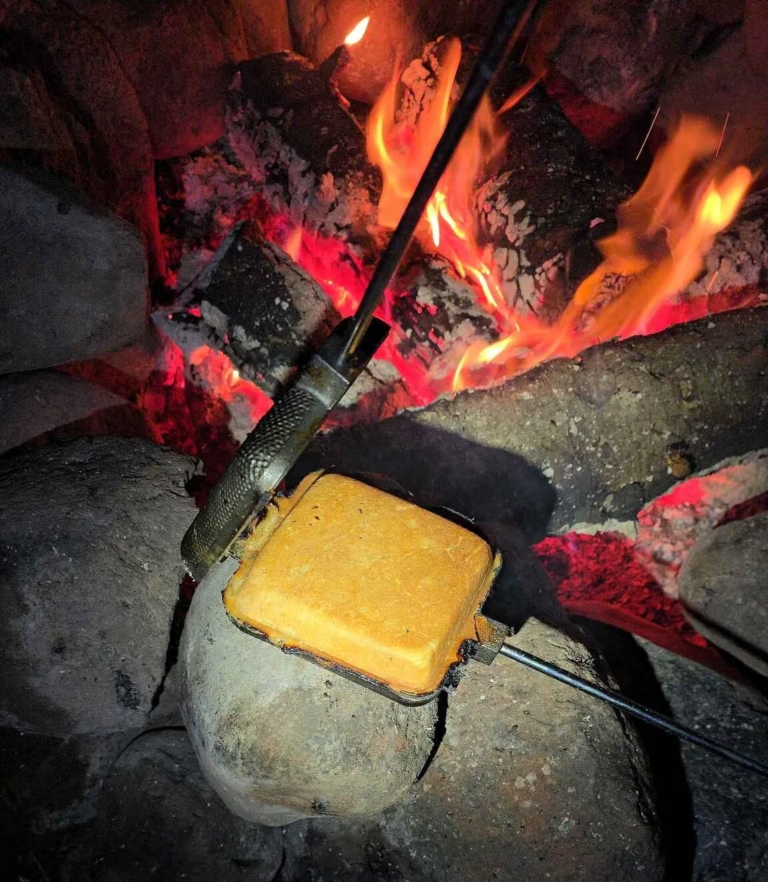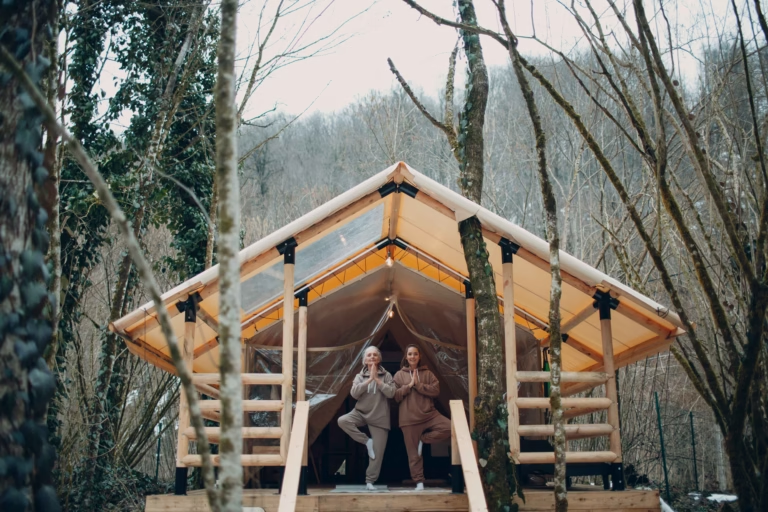Tent Living Full-Time: Save Money, Live Simply
Living in a tent full-time might sound wild at first – like it’s only for hardcore adventurers or folks down on their luck. But more people are choosing tent life on purpose these days, chasing freedom, a real connection with nature, and a simpler way to live.
With the right prep and a little grit, tent living full-time isn’t just possible – it can actually feel rewarding. You might save money and get closer to the outdoors than you ever thought possible.
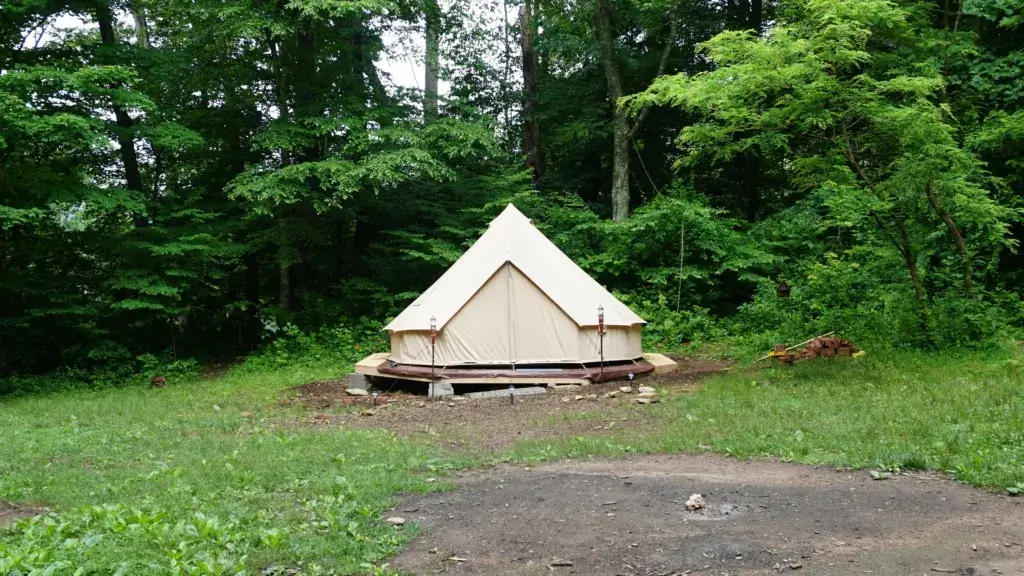
The idea of ditching four walls and a mortgage for canvas and fresh air? It’s catching on for all sorts of reasons. Some people want to shrink their environmental impact, others want to cut down on bills, and let’s be real – a lot of us just want to wake up in the woods sometimes.
Full-time tent living offers legit benefits like a smaller carbon footprint, saving cash, and feeling healthier from all that time outdoors.
But it’s not all s’mores and stargazing. You’ve got to face real stuff – dealing with bad weather, finding water, and making peace with a tiny living space. Knowing what you’re in for and gearing up properly makes a huge difference.
Key Takeaways
- Full-time tent living can actually work and brings money savings, eco-friendliness, and a closer bond with nature.
- Success depends on picking tough tents, finding the right spot, and having key gear for water, power, and basic comfort.
- It’s not always easy – weather, space, and missing home comforts are real, but planning and the right attitude make it doable.
Is Tent Living Full Time Right for You?
Before you jump in, you’ve got to get real with yourself. Why do you want this? How much comfort are you willing to let go of? Are you in it for a wild summer or the long haul?
Personal Motivation and Lifestyle Goals
People pick living in a tent full-time for all sorts of reasons. Some are dodging rent and student loans. Others just want more adventure or a deeper connection to the outdoors.
Money matters push a lot of folks into tents. Housing costs drop to almost nothing. But it’s not just about saving – what will you do with that extra cash?
Adventure junkies might want to roam the national parks or just feel less tied down. The nomad vibe is perfect for anyone tired of the usual routine.
Environmental reasons come up a lot, too. Living in a tent means using less energy and shrinking your carbon footprint, which feels pretty good.
It’s not for escaping problems or a quick fix. Full-time tent living takes planning, stubbornness, and the ability to figure stuff out when things get messy.
Set your goals before you commit. Whether it’s saving for something big, seeing the world, or just wanting less stuff, having a reason helps you stick it out when it gets tough.
Readiness for Comfort Trade-Offs
Living in a tent long-term means saying goodbye to a lot of little comforts. Forget hot showers on demand. There’s no magic thermostat.
Space gets tight, even in a big tent. Storage is always a puzzle. Sharing with someone? Personal space is basically gone.
Weather can be brutal. Summer turns your tent into a sauna. Winter? Even the best insulation only goes so far. Rainy days mean you’re stuck inside a small space, hoping for a break in the clouds.
Privacy is rare. Thin tent walls let every sound in. Neighbors at campgrounds might be just a few feet away. Even changing clothes takes some planning.
Hygiene gets tricky. Public showers aren’t always close or clean. Laundry days turn into mini-adventures of their own.
Some people roll with these changes. Others realize they miss home comforts more than they thought. Either way, it’s all about knowing yourself.
Long-Term vs. Seasonal Tent Life
Long-term tent living isn’t the same as camping for a season. A few months might feel like a fun break. Years? That’s a different beast.
Seasonal tent life works for short-term goals. Maybe you want a summer in the parks or to skip winter somewhere warm. Knowing there’s an end in sight makes the tough days easier.
Year-round tent life means you’re facing every season head-on. Winters in cold places need serious gear and planning. Summers in hot spots can be just as rough.
Your gear changes depending on how long you’re out there. Short stints might be fine with basic stuff. Living in a tent for years? You’ll want a sturdy canvas tent, real heating, and a way to get power.
Staying social gets harder the longer you’re on the move. Finding your people or a sense of community in campgrounds takes work.
Legal stuff comes up if you’re in it for the long run. Most campgrounds don’t let you stay forever. You’ll need to research and maybe get permits to stay put.
Flexibility is the big difference. Seasonal tent living is easy to walk away from. Going permanent? You’ll want backup plans and a real commitment.
Key Benefits of Living in a Tent
Tent life comes with some major perks that pull people away from regular houses. You might find yourself spending way less each month, living simpler, and waking up to forest views instead of traffic. If you get bored, you can pack up and move your “house” in a day.
Saving Money and Living Minimally
The money side of tent living is tough to beat. Most folks drop a third or more of their paycheck on rent or a mortgage.
Living in a tent wipes out those housing costs. No more utility bills, property taxes, or insurance headaches.
Monthly costs usually boil down to:
- Food and basics
- Camping fees (sometimes)
- Phone and a little internet
- Getting around and gas
Suddenly, you’re forced to ask – do I really need all this stuff? Tiny storage means every item has to earn its spot.
Minimalism isn’t just about saving money. It clears your head and cuts down on decision fatigue. Less stuff means less cleaning and organizing, too.
Lots of tent folks say they feel lighter and more focused. They put their savings toward travel or other experiences instead of more things they don’t really want.
Reconnect With Nature Every Day
Regular houses separate us from nature. Living in a tent? The walls are gone.
You’ll wake up to birds instead of alarms. Sunrises and stars replace TV screens at night.
Everyday nature perks include:
- Fresh air all through your living space
- Natural light that helps your sleep
- Feeling the seasons change around you
- Wildlife just outside your door
Being outside more often really does lower stress. There’s research showing that time in nature cuts anxiety and helps your mental health.
Tent living also teaches you real outdoor skills. You’ll learn to read the weather, spot plants and animals, and find your way without GPS.
Physically, you’ll walk more, breathe cleaner air, and soak up sunlight for that much-needed vitamin D.
Freedom, Flexibility, and Mobility
The nomad lifestyle is pretty freeing. If you want to move, you just pack up and go.
If bad weather’s coming, you can chase the sun. If you’re tired of your view, there’s always a new one waiting.
This kind of freedom means you can:
- Follow the seasons
- See new places without booking hotels
- Skip crowded tourist spots
- Change neighborhoods whenever you want
Remote work? You can find your ideal work spot and still keep up with your job.
The eco side is a draw, too. Tent living uses less energy, makes less trash, and leaves a smaller footprint.
Lots of tent folks use solar power, collect rainwater, and try to leave no trace. You start to care more about the environment when you see it every day.
The mental freedom is huge. No mortgage, no lease, no one telling you where to be. That’s a kind of independence that’s hard to put a price on.
Biggest Challenges and How to Overcome Them
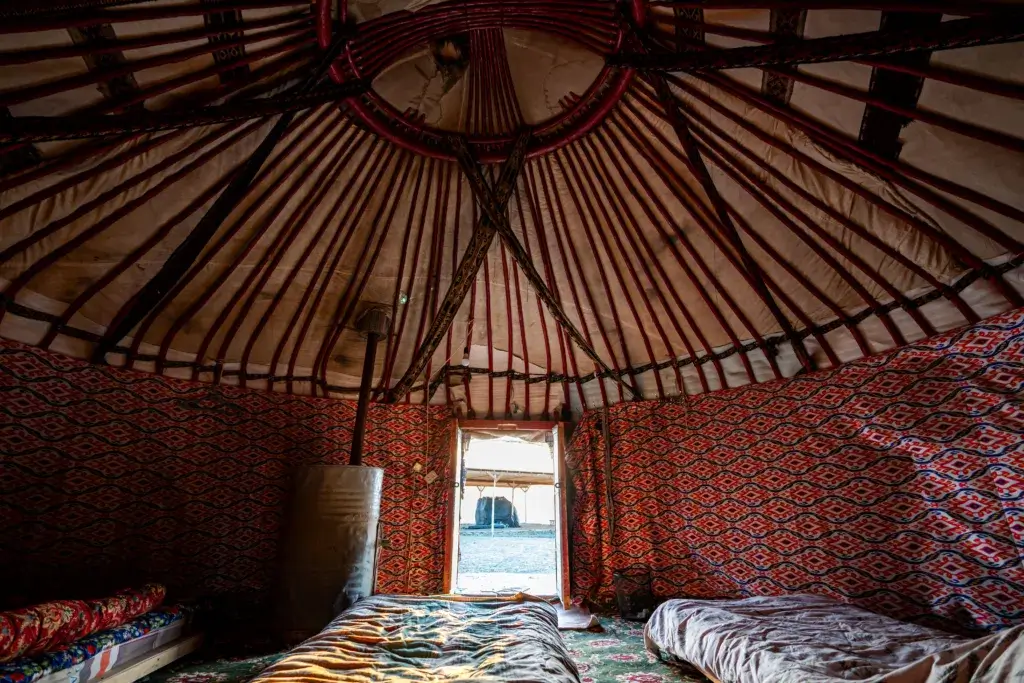
Full-time tent living brings its own set of headaches, honestly. Weather extremes, keeping your stuff safe, and sometimes feeling a bit cut off from others – these are the big ones that most new tent dwellers have to figure out.
Dealing With Weather and the Elements
Weather’s probably the biggest wild card if you’re even thinking about living in a tent full-time. Rain, snow, and crazy temps can turn your cozy setup into a soggy (or freezing) mess fast.
Winter Protection
Cold weather means you’ll need to step up your gear game. A four-season tent with real insulation can make all the difference when winter hits hard.
Some winter must-haves:
- Cold-weather sleeping bags rated to -20°F
- Insulated sleeping pads
- Portable wood-burning stoves
- Extra tarps for wind protection
Summer Heat Management
Hot weather brings its own headaches. Ventilation’s key if you don’t want your tent to turn into a sauna or drip with condensation.
Storm Preparation
Protecting the outside of your tent usually means tossing on extra fly sheets and tightening down those guy lines. Anyone who’s done this a while checks the weather every morning and doesn’t hesitate to move camp if a big storm’s rolling in.
Location Matters
Picking a spot with natural windbreaks, think trees or rocks, helps a ton. Skip low spots that flood when the rain gets wild.
Safety, Security, and Wildlife
Tent life doesn’t come with locks or thick walls. You lose that traditional sense of security, and thin fabric doesn’t stop much, whether it’s a nosy raccoon or a thief.
Securing Valuables
Locked storage containers are a no-brainer for your important stuff. A lot of folks just stash valuables in their vehicles for peace of mind.
Wildlife Precautions
Sealing up your food is non-negotiable if you want to avoid animal visitors. Bear canisters beat hanging food in trees, hands down.
Emergency Preparedness
If you’re far from town, help isn’t coming quickly. First aid skills and a way to call for help are pretty much must-haves.
| Safety Item | Purpose | Priority |
|---|---|---|
| Satellite communicator | Emergency contact | High |
| Bear spray | Wildlife deterrent | High |
| First aid kit | Medical emergencies | High |
| Whistle | Signal for help | Medium |
Personal Security
Camping with friends or in established campgrounds just feels safer. If you’re solo, always let someone know where you are – seriously, it’s worth the hassle.
Staying Social and Connected
Tent living can get pretty lonely if you don’t plan for some people time. Being way out there means you’ll see friends and family a lot less.
Building Community
Long-term campgrounds sometimes turn into little villages. Other campers get it; they’ll lend a hand or just chat when you need it most.
Technology Solutions
Satellite internet and cell boosters keep you plugged in, at least when the tech cooperates. Solar panels and portable batteries help keep your phone and gear ready to go.
Scheduled Social Time
Trips to town for groceries or supplies are perfect for a little human contact. Libraries, coffee shops, and community centers are chill hangouts if you’re craving conversation.
Family Considerations
Families in tents have to think ahead for the kids. Homeschool groups and youth activities help little ones make (and keep) friends.
Work Relationships
Remote workers need to set clear times to check in with the boss. Video calls demand decent internet, which can be a pain to find in the boonies.
Essential Gear and Choosing Your Tent
Your tent and gear can absolutely make or break full-time living. Canvas tents are tough and comfy, while synthetic tents are lighter and easier to haul around. Each has its own quirks, and you’ll want the right extras to turn “camping” into something that doesn’t feel like roughing it every day.
Types of Tents for Full-Time Living
Ditching the house for a tent? You’ll find out quick that not all tents are up to the job. Canvas tents are the go-to for a reason.
Wall tents are about as close as you’ll get to a real room. Their boxy shape and vertical walls give you more space to actually stand up and move around. Hunters and outdoorsy types have trusted them forever.
The bell tent is a little more whimsical. Its round shape and single pole mean a surprisingly roomy inside. That high ceiling? It’s a game-changer for anyone tired of bumping their head.
Canvas cabin tents are awesome for all seasons. They’re tough, comfy, and usually have plenty of windows for airflow.
Geodesic tents are the heavyweights for wind and storms. Their dome shape shrugs off nasty weather. If you’re camping somewhere unpredictable, they’re worth a look.
Canvas Tent vs. Synthetic: The Great Debate
Canvas tents just last longer. They breathe, so you don’t end up with soggy walls. They also handle wild temperature swings better.
Yeah, canvas is heavy and costs more up front. But if you’re in it for the long haul, it’s usually worth the splurge.
Synthetic tents are way lighter and set up fast. They’re great for moving around or if you’re not planning to stay in one spot long. Waterproofing is usually solid right out of the package.
The downside? They don’t breathe, so you get more condensation. And most aren’t built to last through months of daily use.
| Feature | Canvas | Synthetic |
|---|---|---|
| Durability | Excellent | Good |
| Weight | Heavy | Light |
| Breathability | Natural | Poor |
| Cost | Higher | Lower |
| Lifespan | Years | Months |
Canvas really does beat synthetic when it comes to weather resistance and letting your tent breathe.
Must-Have Amenities and Comfort Hacks
Flooring is a game-changer. A wooden platform keeps you dry and warm. Plus, it gives you a flat spot for your stuff – no more lumpy ground under your bed.
Heating matters more than you think. A wood stove with a proper jack can turn your tent into a cozy cabin, even in the dead of winter.
Storing food right keeps critters away. Bear-proof bins and raised shelves are your best friends. Trust me, you don’t want to wake up to a raccoon party.
Water takes planning. Portable water filters like the Travel Berkey handle gallons per hour and don’t even need power.
Gravity-Fed Water Filter with 2 Black Berkey Elements Enjoy Potable Water While Camping, RVing, Off-Grid, Emergencies, Every Day at Home
Power up. Solar panels and portable power stations keep your lights on and your phone charged, even miles from the grid.
A good night’s sleep is everything. Thick sleeping bags, extra blankets, and a way to regulate temp will save your sanity when the weather turns weird.
Working Remotely With Starlink

One of the biggest challenges of full-time tent living is staying connected – especially if you need reliable internet for work. Traditional cell service can be spotty in remote areas, and campground Wi-Fi is usually slow at best. That’s where Starlink comes in.
Starlink is a satellite internet service from SpaceX that delivers high-speed internet almost anywhere you can set up the dish with a clear view of the sky. Unlike older satellite options, Starlink offers speeds fast enough for video calls, streaming, and uploading files, which makes it a game-changer for remote workers and digital nomads (source: Starlink Insider).
Why it works for tent life:
- Coverage almost anywhere – Perfect for national forest campsites, private land, or rural areas where cell towers don’t reach.
- Portable setup – The Starlink “Dishy” can be set up in minutes and moved when you change campsites.
- Remote work ready – Most users report download speeds between 50–250 Mbps, more than enough for Zoom calls or uploading work documents (source: Starlink Service Plans).
- Flexible plans – The “Roam” plan is designed for travelers and RVers, letting you take your service on the road (source: Harvest Hosts).
The downsides? Starlink requires a clear view of the sky (trees and mountains can block the signal), and it does draw power, so you’ll need a solar setup or battery bank to keep it running. It’s also not the cheapest option, with equipment costs around $600 and service starting near $150/month in 2025 (source: Dishy Central).
Still, for anyone who wants to live in a tent without giving up their remote job, Starlink is one of the most reliable ways to stay online.
Setting Up Your Long-Term Camp
Making tent life work long-term really comes down to three things: finding a legal spot, setting up a camp that actually works, and making sure your shelter can handle whatever nature throws at you.
Picking Your Spot: Legalities and Location
That “off-grid” dream? It can get messy if you skip the legal stuff. Where you pitch your tent depends on local laws and zoning, so you’ve gotta do your homework first.
National and state parks usually cap you at 14 days. Cities almost always say no to tent living. Private land is your best bet, whether it’s yours or you’ve got written permission from the owner.
Before you get too settled, check these:
- Camping time limits and local rules
- Zoning laws for your area
- Permit needs for longer stays
- Written permission if you’re on someone else’s land
Double-check the laws before you make things permanent. Some places are chill about it, others will fine you or kick you out fast.
Building a Comfortable and Functional Campsite
A good camp setup is the difference between just surviving and actually enjoying your tent life. The trick is carving out spaces for different needs, even if you’re working with a tiny footprint.
Start with the basics: cooking area, sleeping space, storage, and a hygiene spot. Keep your kitchen downwind and at least 10 feet from your tent. Bins and hanging organizers are lifesavers for keeping your stuff handy and dry.
Must-have camp zones:
- Kitchen with a stable cook surface and safe food storage
- Storage using weatherproof bins and hanging bags
- Hygiene station (think water jug and privacy tarp)
- Work or chill area with a seat and table
If you’ve got the space, consider a bigger tent or a tarp extension for rainy days. Pick a tent that fits all your gear and lets air flow – it’s worth it for your health and sanity.
Don’t forget drainage. A little trench or some rocks can keep your sleeping spot dry when storms roll through.
Creating Shelter for All Seasons
The weather will test every part of your shelter setup all year long. Building a weather-resistant shelter isn’t just about owning a good tent – it takes layers and seasonal tweaks.
Summer preparations are all about airflow and shade. Throw up tarps for sun protection and open up your tent as much as possible for a breeze.
Pick a campsite that catches the morning wind but stays out of the brutal afternoon sun.
Winter readiness means insulation and blocking the wind.
- Ground insulation—think foam pads or reflective blankets
- Windbreaks from tarps or whatever nature provides
- Snow management to prevent tent collapse
- Emergency heating (always double-check if it’s safe for your tent!)
Spring and fall bring a mixed bag of weather, so flexibility is key. Layer your shelter setup so you can quickly add or peel away protection as needed.
Waterproofing is huge during these in-between seasons. Don’t let a surprise storm catch you off guard.
Invest in quality sleeping bags and clothing to stay warm and dry when it gets chilly. A four-season tent is a solid base, but tarps, ground covers, and extra insulation really round things out.
Always test your shelter before settling in for real. Spend a few nights in different weather if you can, just to spot any weak spots and fix them before they turn into problems.
Daily Life, Sustainability, and Staying Sane
Living in a tent day after day means getting clever with food storage, waste, and sustainability. It’s not just about surviving; it’s about keeping your body and mind in good shape so you can actually enjoy the experience.
Food, Water, and Waste Management
Smart food storage keeps meals fresh and animals out. Sealed bins are great for dry stuff like rice, while a cooler with ice packs handles perishables for a few days.
Portable water filters like the Travel Berkey can clean up to 2.75 gallons an hour, no electricity needed. This makes living off-grid way less stressful.
Bear canisters or hanging food with a rope keep critters from snacking on your supplies at night.
Composting toilets like the Nature’s Head tackle waste without plumbing. They break things down naturally, and the built-in fans help with odor.
With Close Quarters Spider Handle Design
Dump gray water from dishes at least 200 feet away from streams or lakes. Biodegradable soap helps keep your impact low.
Simple camp kitchens with a basic stove make cooking way less of a hassle.
Staying Safe and Healthy
Mental health can take a hit in tight spaces. Try to get outside every day, even just a walk helps. Books and podcasts are life-savers on long, rainy days.
For physical health, stick to basic hygiene. Solar shower bags warm up water for a real wash, and wet wipes work for quick cleanups.
Stash food properly and stay aware of wildlife. If you’re in bear country, keep bear spray handy. Check your first aid kit often and restock as needed.
Weather can turn fast, so prep ahead. Use a couple of weather apps to track storms. Emergency supplies like extra food and water are your safety net.
Sustainable Living Tips for Tent Dwellers
Solar panels and portable power stations cut down on generator use. The Bluetti Solar Generator Elite 30 power station can handle up to 600W of solar charging, which is pretty impressive for off-grid life.
288Wh LiFePO4 Battery Backup 600W, AC Outlets (Power Lifting 1500W), 0-100% in 70 Min, for Camping, Road Trip, Outage (Solar Panel Optional)
Eco-friendly habits for tent living:
- Stick to biodegradable soaps and cleaners
- Follow Leave No Trace rules
- Collect rainwater for chores
- Compost organic scraps if you can
- Choose reusable gear over single-use stuff
Sustainable choices really do make a difference. LED lights use less juice than old-school bulbs, and rechargeable batteries mean less trash.
Water conservation becomes second nature. Quick navy showers save gallons. Catching rainwater with tarps gives you extra for cleaning.
Minimalism just happens when space is tight. You end up buying only what you need, which saves money and cuts down on waste. Multi-use gear is a must in a small space.
Frequently Asked Questions
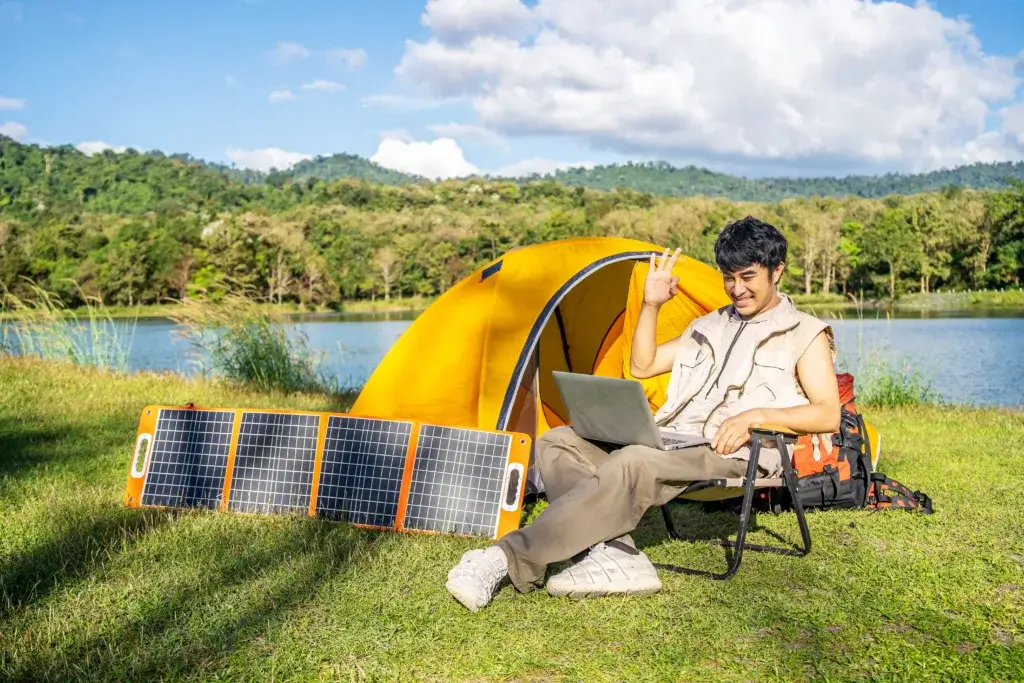
If you’re thinking about tent life, you probably have a million questions about gear, rules, and practical stuff. Here are some common ones – from heavy-duty shelter picks to saving cash and staying comfortable all year.
What are some heavy-duty tents suitable for year-round living?
Canvas wall tents are the classic choice for living in a tent full-time. They’re made of thick cotton that stands up to rough weather and insulates well. You can even set up a wood stove inside for winter.
Bell tents are another comfy option. They’re roomy and built to last, so you won’t feel cramped.
Military surplus tents are tough and usually cheaper. They’re built for harsh conditions and heavy use.
Look for tents with sturdy seams, waterproof coatings, and heavy-duty zippers. Four-season tents are best for snow and cold, but three-season models might work if you’re in milder climates.
How can I make my permanent tent home comfortable in all seasons?
Good flooring makes a world of difference. Lay down carpet or foam pads for insulation and a homier feel.
A wood stove is a game-changer for winter. Just make sure it’s installed safely with proper ventilation.
Throw a tarp or fly sheet over your tent for extra weather protection. It’ll help your tent last longer and keep you drier.
Get a solid cold-weather sleeping bag and an insulated pad for winter nights. Layer bedding and clothes to stay comfortable as temps change.
Set up a rainwater collection system for your water needs. It saves money and means fewer trips to refill.
Are there any places where it’s legal to set up a tent and live for free?
Free camping spots are out there, but you have to look. National forests and Bureau of Land Management land often let you camp for up to 14 days before you need to move on.
State and national parks usually cap stays at about two weeks, and you have to move at least 25 miles before coming back. So, you’ll be moving every few weeks.
Some private landowners let people camp in exchange for work or caretaking. Always get clear agreements about what’s expected.
Even on your own land, local zoning laws might restrict tent living. Permits are sometimes required for longer stays.
Contact local officials to get the rules straight. Regulations can be wildly different from one place to another.
What should I consider before deciding to save money by living full-time in a tent?
Tent living can save a ton on rent and bills, but good gear isn’t cheap up front.
Think about your work situation. If you work remotely, you’ll need reliable internet and power for your devices.
Ask yourself if you can live without daily luxuries like hot showers and climate control. It’s a big adjustment.
Medical emergencies are trickier when you’re off-grid. Have a plan for getting help fast if you need it.
Weather can mess with your plans and even damage your gear. It’s something you’ll always have to watch.
What are the pros and cons of swapping a traditional home for a tent?
The upsides? Freedom, a smaller carbon footprint, and way more time outdoors. It’s good for your body and mind.
You can move whenever you want. No leases, no selling – just pack up and go.
Facing outdoor challenges builds confidence and self-reliance. You might surprise yourself with what you can handle.
But security is a real issue. Tents don’t lock up like houses, and bad weather or animals can cause problems.
Utilities and sanitation take creativity. Water, waste, and electricity are daily puzzles to solve.
It can get lonely, especially in winter or remote spots. If you’re a social person, that’s something to think about.
Can you recommend any tent living hacks for those embracing the minimalist lifestyle?
Let’s be real – tents don’t exactly come with locks. If you’ve got valuables, stash them in locked storage containers or just leave them in your car. It’s a simple way to dodge that sinking feeling when something goes missing.
Wildlife? Oh, they’re clever. Seal your food in airtight containers, or you’ll have bears, raccoons, or even sneaky mice joining your midnight snack. Seriously, they sniff out everything fast.
Try carving out zones inside your tent for different stuff – sleeping, gear, maybe a corner for shoes. Hanging organizers or little bins make a huge difference when you’re short on space.
If you want to keep your phone charged or run a light, grab a solar panel or a portable battery bank. LED lights are a win too – they barely sip power and last way longer than those old-school bulbs.
Don’t just hole up alone. Chat with nearby campground folks or locals. Sometimes you’ll need a hand, or maybe you just want to swap stories by a fire.
Always keep a first aid kit and emergency supplies right where you can grab them. Out here, help isn’t always around the corner, and you’ll thank yourself later.
How do I get reliable internet while living in a tent?
Staying online is one of the trickiest parts of full-time tent living, especially if you work remotely. Here are the main options:
- Starlink Satellite Internet – A portable dish that connects to SpaceX’s satellite network. It works almost anywhere with a clear view of the sky and delivers speeds fast enough for video calls, streaming, and remote work. Plans for travelers (Starlink Roam) start around $150/month, with a one-time equipment cost of about $600 (source: Starlink Insider).
- Cell signal boosters – If you’re near a cell tower but the signal is weak, a booster can amplify it for more reliable 4G/5G service.
- Public Wi-Fi – Libraries, coffee shops, and community centers are good backup options when you’re near town.
For most long-term tent dwellers who need consistent internet, Starlink is the most dependable option, though it does require power from solar panels, a generator, or a battery bank.





